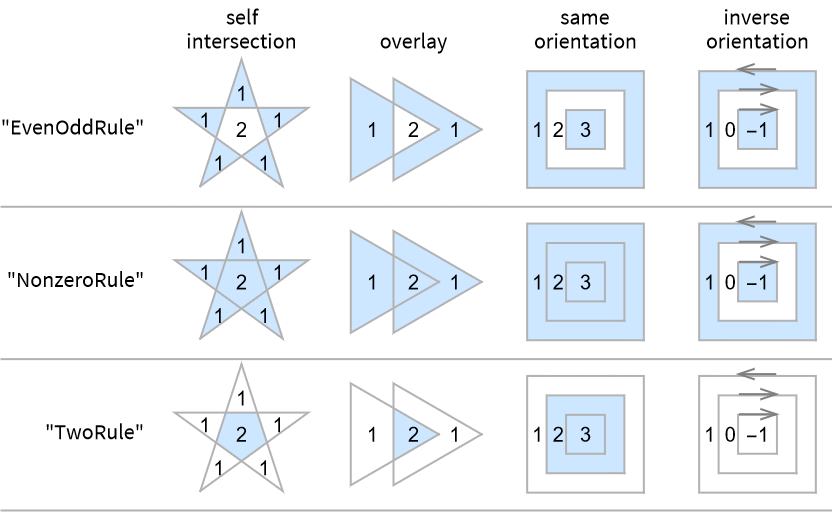WindingPolygon[{p1,p2,…,pn}]
gives a polygon representing all points for which the closed contour p1,p2,…,pn,p1 winds around at least once.
WindingPolygon[{{p11,p12,…},{p21,p22,…},…}]
gives a polygon from the closed contours p11,p12,… and p21,p22,….
WindingPolygon[…,"wrule"]
uses the specified winding rule "wrule" to define the polygon.


WindingPolygon
WindingPolygon[{p1,p2,…,pn}]
gives a polygon representing all points for which the closed contour p1,p2,…,pn,p1 winds around at least once.
WindingPolygon[{{p11,p12,…},{p21,p22,…},…}]
gives a polygon from the closed contours p11,p12,… and p21,p22,….
WindingPolygon[…,"wrule"]
uses the specified winding rule "wrule" to define the polygon.
Details and Options


- WindingPolygon is also known as winding filling rule.
- WindingPolygon is commonly used to define a polygon from self-intersecting closed curves.
- A point p is in the polygon if the number of revolutions of the closed contour around p is not zero. The number of revolutions is given by WindingCount.
- The number of winding counts are given below for each region:
- Different winding rules "wrule" give different polygons. Possible winding rules include:
- WindingPolygon[{p1,p2,…}] is equivalent to WindingPolygon[{p1,p2,…},"NonzeroRule"].
- The points pi can have any embedding dimension, but must all lie in a plane and have the same embedding dimension.
- WindingPolygon takes the same options as Polygon.


List of all options
Examples
open all close allBasic Examples (2)
Scope (14)
Basic Uses (5)
Options (6)
VertexNormals (1)
VertexTextureCoordinates (3)
Texture mapping with 2D polygons:
Texture mapping with 3D polygons:
Repeat a texture by using non-unified texture coordinate values:
Texture mapping is preceded by VertexColors:
Applications (3)
Properties & Relations (2)
WindingPolygon is in general different than Polygon:
CrossingPolygon is an alternate polygon constructor:
Possible Issues (2)
WindingPolygon always gives full-dimensional components:
The points in WindingPolygon must lie on a plane:
Related Guides
-
▪
- Polygons
History
Text
Wolfram Research (2019), WindingPolygon, Wolfram Language function, https://reference.wolfram.com/language/ref/WindingPolygon.html.
CMS
Wolfram Language. 2019. "WindingPolygon." Wolfram Language & System Documentation Center. Wolfram Research. https://reference.wolfram.com/language/ref/WindingPolygon.html.
APA
Wolfram Language. (2019). WindingPolygon. Wolfram Language & System Documentation Center. Retrieved from https://reference.wolfram.com/language/ref/WindingPolygon.html
BibTeX
@misc{reference.wolfram_2025_windingpolygon, author="Wolfram Research", title="{WindingPolygon}", year="2019", howpublished="\url{https://reference.wolfram.com/language/ref/WindingPolygon.html}", note=[Accessed: 07-December-2025]}
BibLaTeX
@online{reference.wolfram_2025_windingpolygon, organization={Wolfram Research}, title={WindingPolygon}, year={2019}, url={https://reference.wolfram.com/language/ref/WindingPolygon.html}, note=[Accessed: 07-December-2025]}